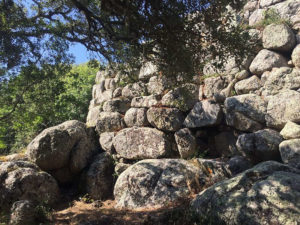Corpo Pagina
The municipality of Tempio Pausania is located in the heart of Gallura, in the north-eastern part of Sardinia. The oldest traces of human settlement date back to the Neolithic and are testified by the discovery of flint and obsidian tools.
From a later period, but still in the pre-Nuragic period, are the ceramic containers found on the slopes of Mount Limbara, probably used in a pastoral context and attributable to Abealzu-Filigosa culture of the Copper Age (3300-2300 BC).
Many more are the testimonies from the Nuragic era: the village of Monte Lu Finocchiu, the tombs of Monte di Deu and numerous nuraghi including Izzana, probably the largest in Gallura, Polcu and above all Maiori, a single tower built in granite, of mixed typology due to the co-presence of construction elements of both corridor and tholos nuraghi. Scholars think that a village of huts arose around the nuraghe; archaeological investigations have in fact returned numerous ceramics including cups, jars, pans and bowls.
From Tempio Pausania comes a bronze hammer, with a parallelepiped shape and a central hole for the handle, used to split rock, dating back to the Final Bronze Age and currently exhibited in the National Archaeological Museum of Cagliari.
Some scholars believe that Tempio Pausania should be identified with the Roman military station of Gemellae, built in the imperial age (end of the 1st century BC) near Calangiani (today’s Calangianus). Others, however, place Gemellae in Milizzana area, at the foot of Mount Limbara, where remains from the Roman era have been found (roads, brick walls and milestones) and whose name derives from the settlement of an ancient Roman militia, perhaps a double legion or a twin auxiliary cohort made up of Sardinians and Corsicans, operating in this area to counter the local populations.
Finally, a more recent hypothesis proposes the identification of Temple Pausania with the rural sanctuary “Hereum” cited by Ptolemy, dedicated to Hera-Juno.
Featured image: Nuraghe Izzana – ph.credits –
Franco-from-Tempio-Pausania-Sardinia-Italy-via-Wikimedia-Commons

Nuraghe Majori – ph.credits: ©-Benoît-Prieur-via-Wikimedia-Commons

